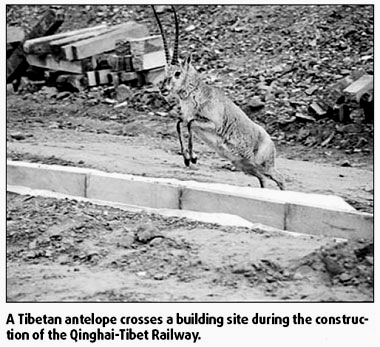The rare Tibetan antelopes, or chiru, that live on the Qinghai-Tibet plateau have adapted well to the high-speed trains that occasionally fly by above them, a zoologist has said.

"The heavy use of the underpasses shows the animals' migration habits have not been disturbed by the railway," Yang Qisen, who has been responsible for monitoring the railway's impact on wildlife since it opened five years ago, told China Daily.
A report produced by Yang and his team was published last month in the science journal Nature.
Yang, who is a researcher with the Institute of Zoology under the Chinese Academy of Sciences, said a subgroup of 3,000 chiru live mostly in eastern Qinghai province. However, every June, pregnant females and young members of the herd migrate to the Kekexili region of western Qinghai and northeastern Tibet to give birth.
The animals make their return journey in August, which means they pass under the railway twice a year, he said.
For the past five years, between June and September, Yang and his team have patrolled the railway to monitor the impact it has had on local wildlife. They have paid close attention to the migration patterns of the chiru.
In 2004, 96 percent of the migrating antelopes were seen using the underpasses. After 2005, the figure rose to 98 percent, Yang said.
Xia Lin, who co-authored the Nature report said: "The antelope certainly seem to have adapted to the railway."
But conclusions should not be drawn overnight and the situation still requires monitoring, she said.
"We can't say the railway has had no impact on the environment, but it does seem to be small," she said.
The situation was different, however, during the construction of the railway, Yang said.
In 2003, the year building work began, 75 percent of the antelopes did not migrate. They stopped close to the construction sites in eastern Qinghai and gave birth there, he said.
Prior to the construction of the railway, Yang and his team conducted an environmental impact assessment and also designed the first underpass.
(China Daily May 8, 2008)